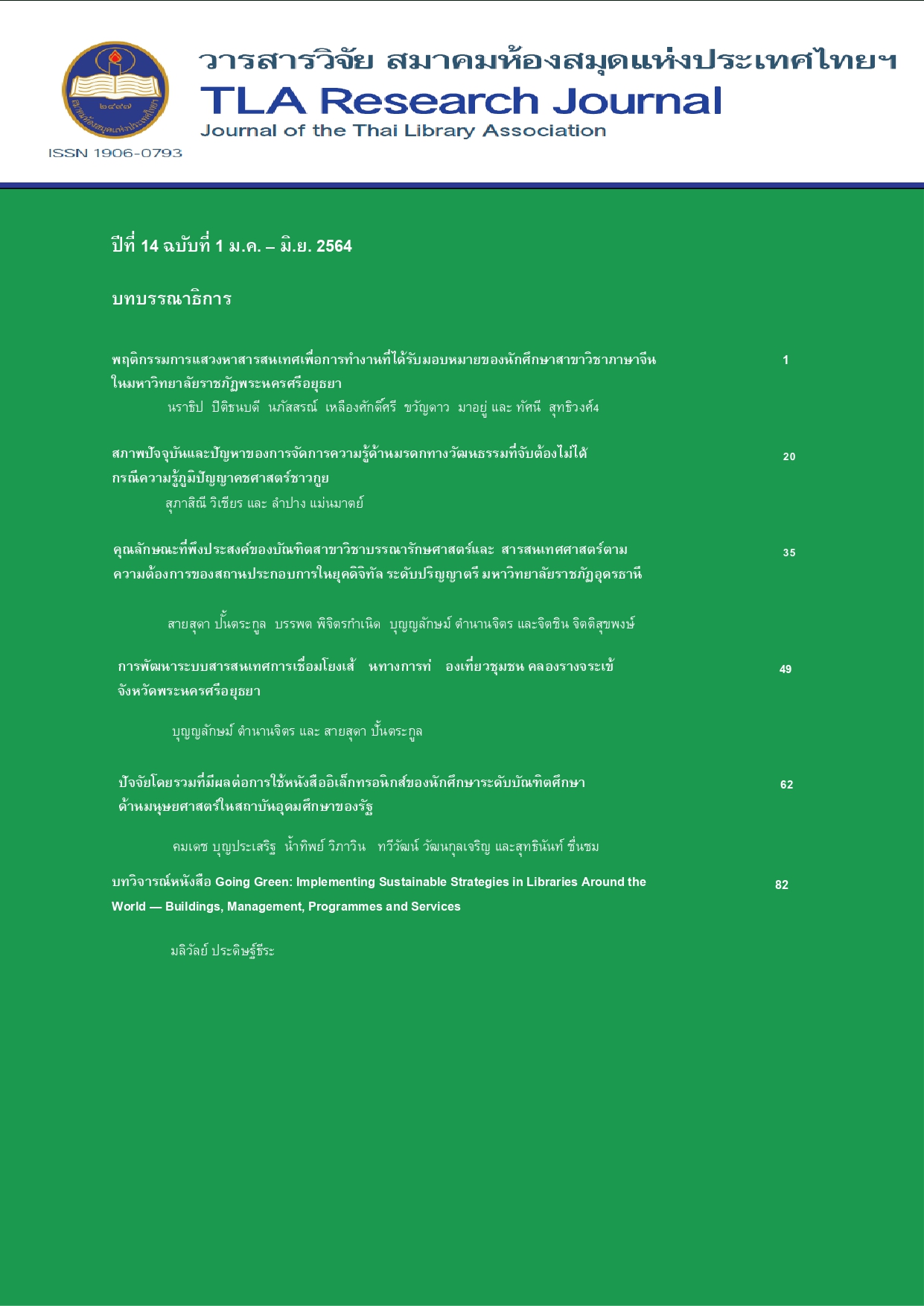Overall Factors Affecting E-books Usage of Humanities Graduate Students in Public Universities
Main Article Content
Abstract
This research paper aims to study the factors both directly and indirectly affecting the use of e-books among humanities graduate students in public universities. This research uses a mixed method by separating the sample into 2 groups. Group 1 consists of 374 graduate students in the fields of humanities, languages, linguistics, literature, culture, history, archeology, philosophy, religion and theology. Group 2 consisted of 55 key informants, administrators and lecturers from the humanities faculty and library administrators from 9 public universities. The research instruments were structured in-depth questionnaires and interviews. The statistics used for quantitative data analysis were percentage, mean and standard deviation. The qualitative data were analyzed by content analysis method.
The results of the research showed that, Overall factors affecting e-book usage of humanities graduate students in public universities such as user factors, Information technology factors, teaching-learning factors, and information resource factors. The most success affect factors is the user factors. The sub-factors that affect usage the most are the perception of benefit, the reading tools, the attitudes and motivation. Information technology factors is the most variable that affects usage the most is the internet signal. The indirect factors affecting e-books usage among humanities graduate students which are teaching and learning factors and information sources. The variable that affects e-books usage the most are the suggestion of digital resource by teachers and the transformation of rare books in academic libraries to digital form.
Article Details
บทความทุกเรื่องที่ลงตีพิมพ์จะได้รับการตรวจอ่านโดยผู้ทรงคุณวุฒิ ความคิดเห็นและบทความที่ปรากฏในวารสารนี้ เป็นของผู้เขียนซึ่งมิใช่เป็นความคิดเห็นของคณะผู้จัดทำ และมิใช่ความรับผิดชอบของสมาคมห้องสมุดแห่งประเทศไทยฯ การนำบทความในวารสารนี้ไปตีพิมพ์ซ้ำต้องได้รับอนุญาตจากคณะผู้จัดทำ
All articles submitted for publication will be reviewed by the academic reviewers. The editorial board and TLA claim no responsibility for the content or opinions expressed by the authors of individual articles or columns in this journal. Reprinting of any articles in this journal must be permitted by the editorial board.
References
Beisler, A., & Kurt, L. (2012). E-book workflow from inquiry to access: Facing the challenges to implementing e-book access at the University of Nevada, Reno. Collaborative Librarianship, 4(3), 96-116.
Botero, C., Carrico, S., Dygert, C., & Lightcap, P. (2009). E-Books: The Past Is Not the Future. Florida Libraries, 52(2), 10-15.
Chan, G. R.Y.C. & Lai, J. K. (2005). Shaping the strategy for e-books: A Hong Kong perspective. Library Collections, Acquisitions and Technical Services, 29, 205-219.
Choorueangsuk, J. (2009). The usage of and needs for electronic books : a case study in the health science library, prince of Songkla university. Songkha: Prince of Songkla University. [in Thai]
Chu, H. (2003). Electronic books: Viewpoints from users and potential users. Library Hi Tech, 21(3), 340–346.
Croft, R., & Bedi, S. (2005). eBooks for a distributed learning university: The Royal Roads University case. Journal of Library Administration, 41(1), 113-137.
Croft, R., & Davis, C. (2010). E-books revisited: Surveying student e-book usage in a distributed learning academic library 6 years later. Journal of Library Administration, 50(5-6), 543-569.
Dewan, P. (2012). Are books becoming extinct in academic libraries? New Library World, 113(1/2),
27-37.
Falc, E. O. (2013). An assessment of college students' attitudes towards using an online e-textbook. Interdisciplinary Journal of E-Learning & Learning Objects, 9, 1-12.
Gregory, C. L. (2008). "But I want a real book" An investigation of undergraduates’ usage and attitudes toward electronic books. Reference & User Services Quarterly, 47(3), 266-273.
Hoseth, A., & McLure, M. (2012). Perspectives on e-books from instructors and students in the social sciences. Reference & User Services Quarterly, 51(3), 278-288.
Hwang, J.-Y., Kim, J., Lee, B. and Hwan Kim, J. (2014). Usage patterns and perception toward e-books: Experiences from academic libraries in South Korea. The Electronic Library, 32(4), 522-541.
Khemakrothai, W. (2015). E-book Usage of Students in Kasetsart University. PULINET Journal, 2(2), 37-44. [in Thai]
Lamothe, A. (2013). Factors influencing the usage of an electronic book collection: Size of the e-book collection, the student population, and the faculty population. College & Research Libraries, 74(1), 39-59.
Li, C., Poe, F., Potter, M., Quigley, B., & Wilson, J. (2011). UC libraries academic e-book usage survey. UC Office of the President: California Digital Library. Retrieved from https://escholarship.org/uc/item/4vr6n902
Ramaiah, C.K. (2012a). E-books: Past, present and future. DESIDOC Journal Of Library & Information Technology, 32(2), 79-82.
Ramaiah, C.K. (2012b). Users' perception about e-books in India. DESIDOC Journal of Library & Information Technology, 32(2), 86-94.
Rogers, E.M. & Shoemaker,.F.F. (1971). Communication of Innovations : A cross cultural approach. New York: The Free Press.
Saunders, L. (2015). Academic libraries’ strategic plans: Top trends and under-recognized areas. Journal of Academic Librarianship, 41(3), 285–291.
Tsai, W-C. (2012). A study of consumer behavioral intention to use e-books: the Technology Acceptance Model perspective. Innovative Marketing, 8(4), 55-66
Wilson, T. (1997) . Electronic publishing and the future of the book. Information Research, 3(2) Available from http://informationr.net/ir/3-2/paper39.html


